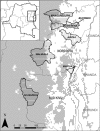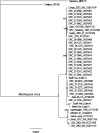Human Monkeypox in the Kivus, a Conflict Region of the Democratic Republic of the Congo
- PMID: 26283752
- PMCID: PMC4596588
- DOI: 10.4269/ajtmh.15-0095
Human Monkeypox in the Kivus, a Conflict Region of the Democratic Republic of the Congo
Abstract
Monkeypox (MPX) is a zoonotic Orthopoxvirus infection endemic in central and western Africa. Human MPX cases occur in the central and northern regions of the Democratic Republic of the Congo (DRC), and this is the first report of confirmed MPX cases in the forested areas of North and South Kivu Provinces, with a detailed epidemiological investigation for one case. The location of each case is within areas predicted to be suitable for MPX virus transmission based on an ecological niche model. Phylogenetic analysis places these viruses in the Congo Basin clade.
© The American Society of Tropical Medicine and Hygiene.
Figures



References
MeSH terms
LinkOut - more resources
Full Text Sources
Other Literature Sources
Medical

